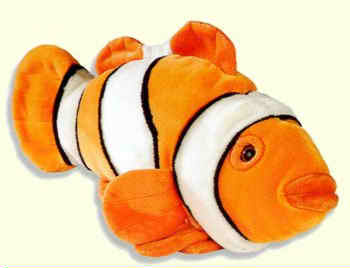|
|
The Clown Fish
The Clownfish belongs to the family Pomacentridae. There are
twenty-eight recognized species of Clownfish. Most of them
belong to genus Amphiprion. Depending upon the species of
Clownfish they can be overall yellow, orange, red or even
black. Most have white bars, striping or patches. The most
well-known Clownfish pattern is the orange with vertical
white stripes running down where the tail meets the body,
across the midsection, and encircling the head.
The largest Clownfish ever recorded was seven inches (nearly
eighteen centimeters) in length but most are more like three
to four inches (six to ten centimeters) long.
The Clownfish has a symbiotic mutualism relationship with
the anemones. The Clownfish makes its home in an anemone;
they have built up a resistance to the anemone's poisonous
effects. The stinging tentacles of the anemone protect the
Clownfish from predators and the waste from the Clownfish's
feeding feeds the anemone. Sometimes they actually feed the
anemone.
Clownfish prefer to make their homes in sea anemones but
when a sea anemone isn't available they may settle for a
large polyp stony coral or some varieties of soft coral. If
the Clownfish settles into a coral in your aquarium you will
have to watch to see if the Clownfish's skin becomes
irritated. If this happens the coral may die.
If the Clownfish adopts a coral or sea anemone they will
defend it as it is their territory. Because the food source
is abundant in a fish tank they may never wander too far
away from home. This is because there is less pressure to
forage for food.
Captive bred Clownfish may not have the same instincts as a
wild Clownfish. They may not decide to live in a sea anemone
and may have to be coaxed into living in one. There is no
guarantee that a sea anemone will host a Clownfish so you
will have to be careful when doing this.
Clownfish are popular aquarium fish. It is recommended that
you keep your Clownfish in a ten gallon tank or more and
that you buy one that has been born in captivity rather than
a wild caught Clownfish that is more likely to die. This is
because wild caught Clownfish are commonly caught using
methods like dynamite fishing that shocks the fish, or nets
with rockhoppers that stress the fish. Tank bred Clownfish
are more resistant to disease and less affected by stress
than wild Clownfish.
Amazingly beautiful and incredibly adorable
plush stuffed Clownfish
Guaranteed to give you those Warm, Fuzzy Wuzzy
Feelings

Folks who have purchased these soft
stuffed Clownfish consistently tell us how
much fun they and their children are having with them!
If you or someone you know is suffering from the
old couch potato syndrome.... then these stuffed
Clownfish are the perfect Cure!
These exceptionally cute stuffed Clownfish are
a pretty cool thing to give as gifts
for that special person in your life.....

Be certain to check out all the stuffed sea life & fish
at the Stuffed Ark logo above!
A satisfying online shopping experience.
|